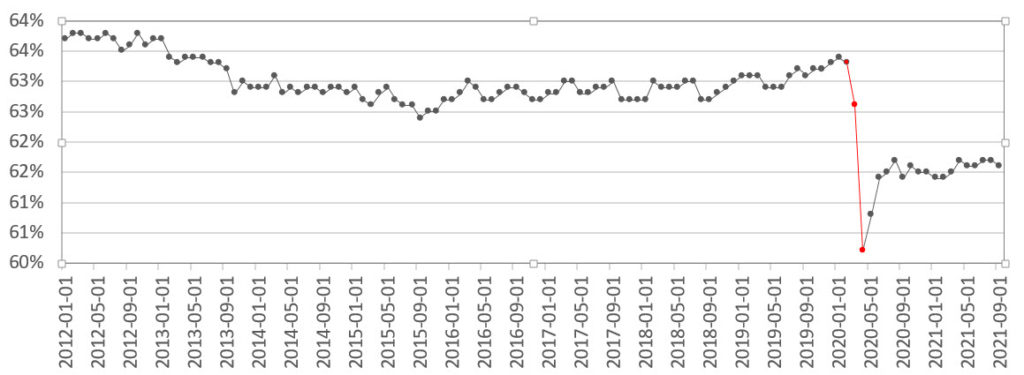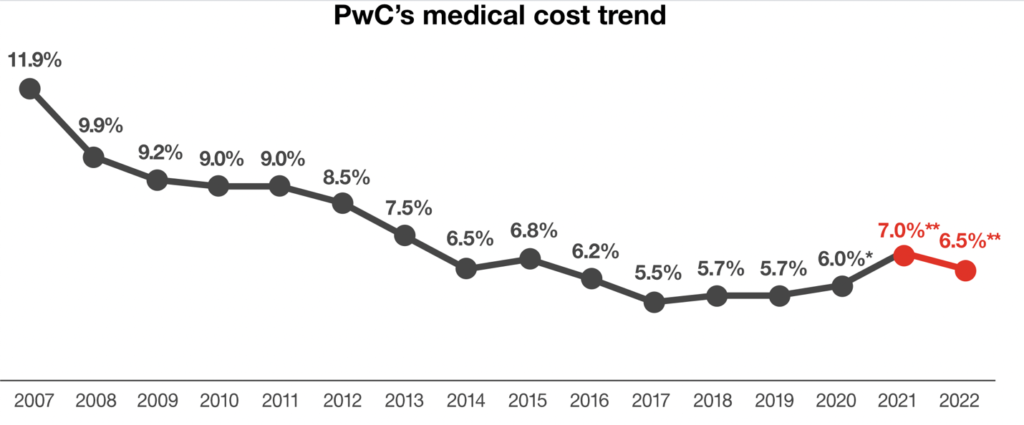Social trends facing business in 2022 and beyond

Editor’s Note: This article is part of an annual four-part series on trends impacting small and midsize businesses. In Part I, we study social trends for 2022.
As we reflect on a period of unparalleled change, we look forward to social trends that will shape our strategy in the years ahead.
Other 2022 trends
Part 2: Technology trends facing business in 2022 and beyond
Part 3: Ecological trends facing business in 2022 and beyond
Part 4: Economic trends facing business in 2022 and beyond
Labor participation rate
Among the more shocking indicators is the number of Americans who have elected not to work at all. September’s participation rate was at 62%, and at only 56% among women. A record 4.3 million workers quit their jobs in August of 2021. America’s acute talent crisis will likely persist for years.
Labor force participation rate

Source: Federal Reserve Bank of St. Louis
Factors include:
- Poor economics for young parents: It is common for mothers to earn $20 per hour and pay $15 per hour for child or elder care. The Biden administration has proposed new legislation to provide government-subsidized childcare for struggling workers.
- Vaccination policies: Novant Health, United Airlines and other companies are terminating unvaccinated employees. The September jobs report numbers were dramatically impacted by a drop in education employment, in part due to some educators being unwell or unable to return to work.
- Average wages increased 0.6 percent in September (7 percent annually adjusted). Employers are trying to mitigate the eroding job market by paying overtime, outsourcing or utilizing automation. The rush for offshoring has already begun.
- Government subsidies have ushered some workers to the sidelines. Participation rates have declined as the Bureau of Labor Statistics noted an increase in the number of “discouraged workers.”
Top social issues
Online polling suggests that Americans care most about the following 10 social issues:
- Poverty: More Americans are living in poverty today than during any time since the 1990s. 2020’s official poverty rate was 11.4 percent, up from 10.5 percent in 2019. This has been the first increase after five consecutive yearly declines.
- Civil rights: It is estimated that between 15 million and 26 million people participated in the Black Lives Matter protests in the United States, making them the largest protests in our nation’s history.
- Pollution: In terms of greenhouse gas production, the United States is second only to China. The 2021 “State of the Air” report found that although there has been nationwide improvement in air pollution, more than 40 percent of Americans currently live in places with unhealthy levels of pollution.
- Education: There have been more conversations around U.S. public school curriculum and university tuition. States comprise 44 percent of education funding in the United States, which places pressure on school budgets. Less than 40 percent of graduating seniors have mastered reading and math. There is a sea change in colleges and universities, as the U.S. government has stopped collecting student debt and the Biden administration has proposed free Community College.
- Affordable housing: More than 11 million U.S. households spend over half their monthly income on rent. While we strive for solutions, the reality is that the economics of homelessness are daunting.
- Homelessness: Over 500,000 people in the United States are homeless. Even at $100,000 per unit, it’s hard to make a dent in the problem in communities with rampant homelessness like Los Angeles, Tacoma and Spokane.
- Health care reform: Deloitte health actuaries project a deceleration in health spending, likely creating a $3.5 trillion “well-being dividend” by 2040.
- Terrorism: It seems it’s not a matter of if the United States will be subject to another major terrorist attack, but when. “Threats have become … increasingly complex and volatile in 2021,” according to the U.S. Department of Homeland Security. “These threats include those posed by domestic terrorists, individuals and groups engaged in grievance-based violence, and those inspired or influenced by foreign terrorists and other malign foreign influences.”
- Climate change: Last month, the World Meteorological Organization projected a 40-percent chance that Earth will cross the 1.5-degree threshold for at least one year by 2026.
- Racism: Opinions on the severity of racism and its impacts are mixed. Polls found that the percentage of Americans with an unfavorable impression of police rose from 18 percent in 2019 to 31 percent in 2020. However, calls for defunding the police have cooled amid the realization that increased training of police officers and the shift toward community policing will require more investment, not less.
Family-friendly environments
Employers are under pressure to adapt to more family-friendly environments. New recruits point out the difficulty in assessing work policies online.
Parents have struggled with virtual schooling and canceled pre- and after-school care, at a time when they need it most.[i] While there are childcare voucher programs, parents are having difficulty finding open spots in the facilities that accept them. Those facilities have had to reduce capacity because of social distancing and an inability to find talent.
The Gen Z gap
Generational gaps were amplified during the pandemic, as boomers contemplated expediting retirement and felt more displaced by digital transformation. Given the depressed work participation rate among tenured workers, the focus has moved from Gen X to Gen Z (those 24 and younger). Gen Z expects the following of their employers:
- Be values-driven and aligned with their personal value system
- Have specific programming for diversity, equity and inclusion
- Provide economic security
- Are more flexible about work schedules. 58 percent say they are willing to work nights and weekends if they can earn a higher salary.
- Communicate clearly and are transparent in their practices.
- Are competitive on compensation. 54 percent of Gen Z job seekers list cash comp as their first priority.
Escalating health care costs
Healthcare costs are surging after a marginal decline over the last few years. A PWC study reflects health care cost increases of 6.5 percent in 2022 — an indicator of the pandemic’s persistent effects. Health care has increased faster than corporate benefit costs, in part absorbed by the U.S. government.
Health Care Costs

Source: PWC
Health care inflation feels like a house of cards. The health care burden for employers will certainly escalate in a post-pandemic world, especially given all the soft costs required to administer safety, health and wellness. Employers need to expand their plans to include more mental health benefits.
Actuaries point out that the Medicare Part A fund will run out of money in five years. There is a fight in Congress about whether Medicare should be “means tested.” Between now and 2023, more than 20 million new members will enroll. By 2023, Medicare will rise from 3.7 percent of GDP to 5.3 percent, which does not account for the increases in private health care costs. Congress only has two choices: reduce benefits or increase Medicare taxes (taken as payroll taxes).[ii]
Violent crime surge
While total crime declined during COVID, violent crime rose dramatically. There were 25 percent more homicides last year, which are up another 13 percent in 2021.[iii] On a per capita basis, crime is up in New Orleans, Cincinnati, Milwaukee, Philadelphia, Minneapolis and Atlanta.
The financial impact of crime is evident. One study found that each crime on a block is associated with a 0.2 percent decline in construction permits and a 1.8 percent decline in renovations on that street. Minneapolis asked for federal COVID relief assistance to invest in its police department.
The collision of recruiting and social media
A CareerBuilder survey revealed that 70 percent of hiring managers are visiting the profiles of candidates on Facebook, TikTok and Instagram. Hiring experts point out that such screening creates bias and is a poor indicator of whether a candidate will succeed in their role. Information gathered through such methods may even be illegal.[iv]
Ironically, a casualty of the post-COVID hybrid work environment may be the career advancement of women.[v] Work-from-home parents have lower rates of promotion. A recent poll of young parents found that 34 percent of women wish to work at home five days per week, compared to 23 percent of men.
Given the talent supply shortage, employers are targeting mid-career professionals who had taken a break.[vi] Amazon recently announced a program designed to recruit 1,000 employees who may require reskilling but have years of technical and leadership training. Each will receive a 16-week onboarding program offered as a “returnship.” Employee referrals are a particularly effective method for identifying candidates looking to return to work.
Social media trends
In terms of broader social media trends, the pace of digital transformation is only accelerating as social media is the preferred medium for digital dialog.
- Artificial intelligence is driving higher consumption of media, more precise keyword research, product recommendations, reviews, and e-commerce conversion.
- Agile marketing is facilitating faster activations and better results. Voice and visual search are enabling mobile devices for all types of transactions (marketers need to ensure their products are voice searchable).
- Influencer marketers are becoming more specialized and realizing higher engagement rates.
- Data protection is becoming a more important consideration among marketers.
In 2022, marketers will ramp up their return on marketing investment in ways that are more visible. Those who have a conversion methodology that proves cause and effect will have a competitive advantage over those who don’t.
Food revolution
Consumer food habits are changing radically, which is not just a result of people growing their own vegetables. Consumers are more concerned with nutrition, the environment and their digestive health. Trends consumers are focused on include:
- The pace of nature. Consumers are aware of ingredients that are locally available based on the seasons. Protein fortification has a growing influence over menus and diets.
- Boosting immunity. There is greater awareness about supplements and their impact on functional food and drink. Consumers are simplifying and demanding freshness and purity.
- Consumers are experimenting with everything from custom cocktails to cooking more exotic cuisines such as those from Sri Lanka and Turkey. Clicks for do-it-yourself cooking videos are up 45 percent as consumers seek out new recipes and flavors.
- Consumers see a clear correlation that products that are good for them are good for the planet. Plant-based meats are expected to generate $8 billion in volume by 2025.
- Consumers are sharing their food experiences online with others more than ever.
Corporate responsibility
In the wake of a convergence of social issues, companies are re-evaluating their responsibilities as employers and corporate citizens. While the current narrative is around DEI (diversity, equality and inclusion), public companies who are accountable to investors are setting formal ESG (environmental, social and governance) standards. As companies shift to professional procurement practices, they tend to require vendors to adhere to a similar set of practices around workplace discrimination, compensation and working conditions.
References
[i] Are we in for a double-dip recession? Bloomberg Businessweek, September 27, 2021
[ii] Kiplinger Letter Vol. 98, No. 37
[iii] Kiplinger Letter Vol 98, No. 34
[iv] Harvard Business Review, October 2021
[v] Nicolas Bloom
[vi] Return-to-work Programs Come of Age, Harvard Business Review, October 2021
Related resources
Top decision factors 2021 [report]
Trends facing business in 2022 and beyond
Social trends facing business in 2021 and beyond
Social trends facing business in 2020 and beyond
Category : Economic / Future Trends

